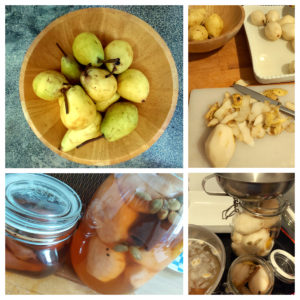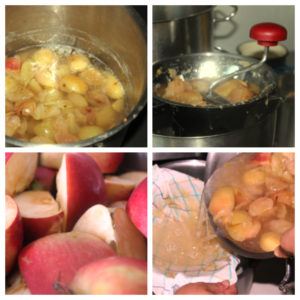delicately spiced these store cupboard gems will lead you on all kinds of culinary journeys….

- 3 Kilos of hard pears (must be hard)
- 2 lemons – juiced (do save the zest for other things – freeze it)
- 450g sugar
- 2 litres water
- 2 – 4 star anise
- 4 – 6 cardamom pods
- 2 sticks cinnamon
- 2 bay leaves
gadgets & gizmos
One very large jar or several smaller jars. I often make them “serving size” so think about your family and choose jars that will take say 2 or 4 or 6 half pears as a half pear is a good serving guide.
How To
- Acidulate a bowl of water with the juice of the lemons. Dont forget this step as this keeps the pears a beautiful bright colour by halting the oxidation process. Plus we will recycle this lemony water into the syrup!
- Peel, core, and quarter the pears. This is tedious and as the pears are hard they can be a tad difficult to peel. Add them to the acidulated water as soon as you peel and core a portion of pear.
- In a large saucepan add the sugar, acidulated water, and spices. Bring to a boil quite fast because the pear pieces can only sit around so long outside the lemon bath. As soon as a little vapour rises from the syrup plunge the pears into the syrup. Let come to a boil again, cook for 5 minutes.
- Pack the jars with the pears. This is where you can indulge your inner pear packing nerd and stack them up neatly. In fact the bigger the jars the easier this is. I insert just one or two star anise and cardamon pods inside. Pears have a subtle flavour and we dont want to overwhelm them.
- Pour the remaining syrup over the pears to cover, leaving a little space approx 1cm of headroom from the tops of the jars. Put on the lids.
- Now water bath them and this is important. If you do not do this they may ferment and they certainly will not keep at room temperature. Either use a bain marie or better for tall jars, your biggest deepest saucepan. Boil in water for 20 minutes.
Leave for a few days to let the syrup infuse.
Ideas and Improvs
Use in crumbles, in frangipane tarts, with a vanilla tart, to acompany blue cheese or just served with a delicious home made custard laced with brandy in winter to warm you up!






